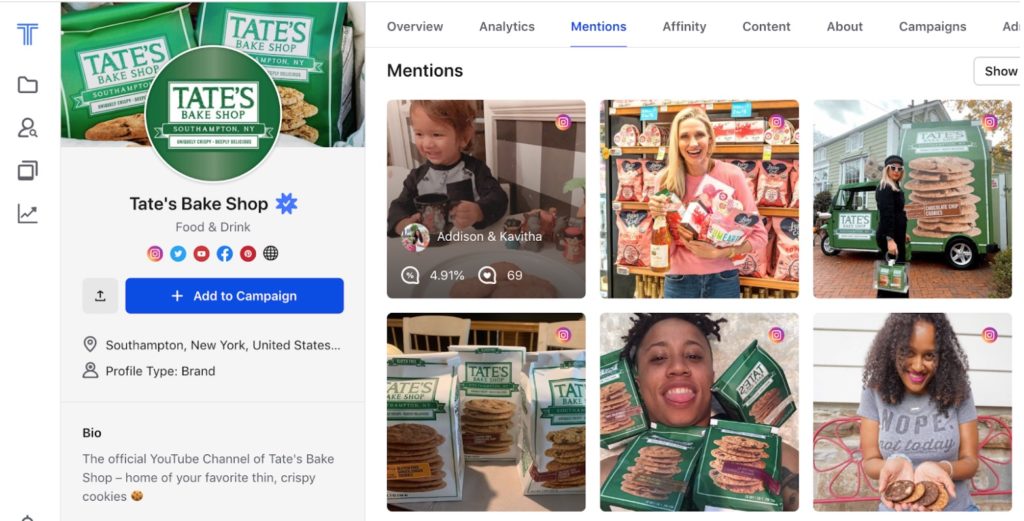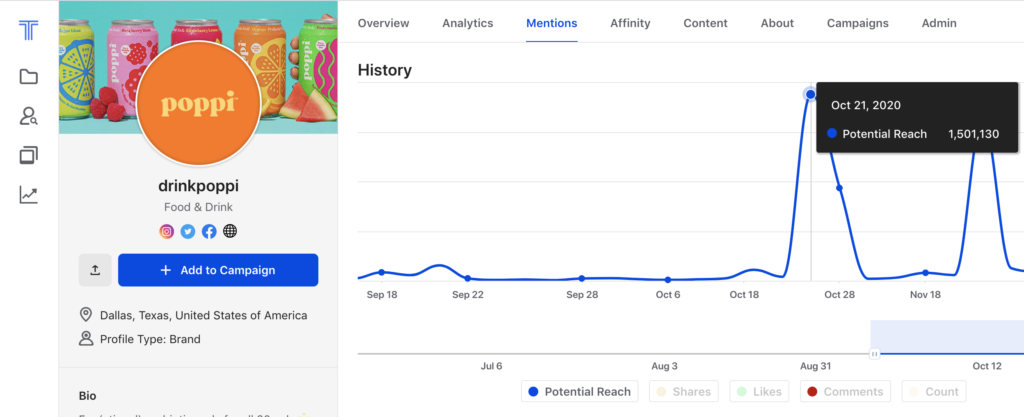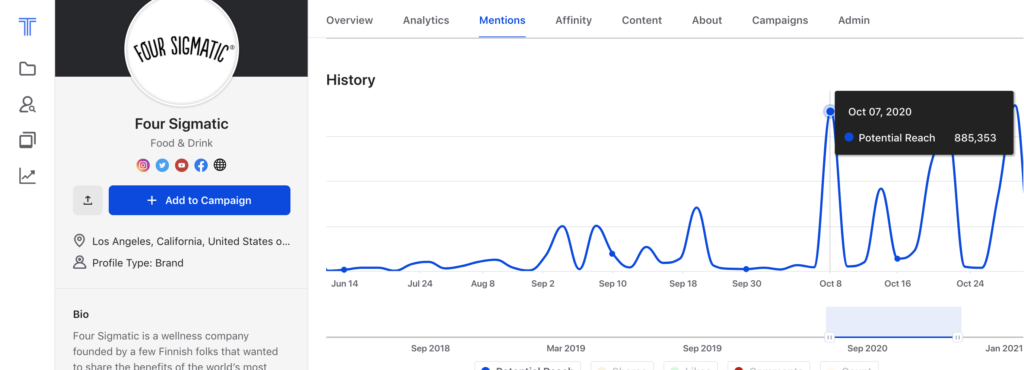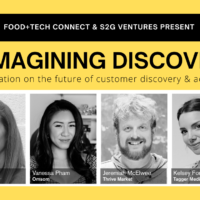
This is a guest post by Kelsey Formost, Director of Content Strategy at Tagger Media.
Food+Tech Connect and S2G Ventures are partnering to host Reimagining Retail, a series of conversations exploring how this unprecedented moment in time will shape food retail over the next five years.
Without the ability to drive product trial through in-store demos and sampling, brands have been forced to rely even more heavily on digital means to drive customer discovery.
While influencer marketing was already a pretty commonplace tactic for brands, in 2020 it became even more essential for brands to work with trusted content creators across social platforms to drive discovery of their products.
Social media has always been ingrained in our daily lives, but according to a recent study, 72% of social media users report spending significantly more time per day on social media. Before covid, the average American was consuming an average of 3.5 hours of social media time per day. After covid, that number has nearly doubled to six hours a day, on average.
Beyond increasing screen time, Covid accelerated our comfort with using social media as a means of discovering and purchasing new products. In fact, because of a surge in on-platform shopping, we’re predicting that all major social platforms will be adjusting their algorithms to boost product discovery and eCommerce in 2021.
Tagger Media, the influencer marketing platform I work for, helps connect brands with the most valuable content creators for their campaigns so they can get their products in front of the right audiences. Over the last year, we found that brands who increased their investment in influencer marketing were able to more seamlessly transition into a pandemic economy and social landscape. By partnering with influencers and meeting consumers where they already were, brands were able to stay top of mind with their existing customer base and drive discovery for new leads.
In advance of the Reimagining Discovery Conversation on January 21, we wanted to share some of the key learnings from 2020 to help brands increase their ROI by leveraging influencer partnerships and staying ahead of upcoming industry trends.
Learning #1: Consumers are increasingly looking to influencers for recommendations and deals
Data shows consumers are purposefully seeking the opinions and recommendations of influencers before they make a purchasing decision. Influencer Marketing Hub reports that 91 percent of millennials trust online reviews as much as they trust recommendations from friends and family. A survey by BrightLocal shows 95 percent of consumers aged 18-34 seek out online reviews before making a purchase, reading an average of 10 reviews before they feel they’re able to trust a brand.
Not only are consumers seeking out the opinions of online creators, they’re actively looking for discount codes and product links from influencers they trust. When it comes time for a consumer to purchase, they often return to the source of discovery – in this case, the influencer – to complete that “last click” step and add the product to their cart.
Recent data shows that long-term partnerships performed best for brands in 2020 which allowed brand campaigns to build momentum with a dialed-in audience. Repetition builds recognition, recognition builds trust, and trust creates sales.
Most marketers are aware of the statistic that a viewer needs to be exposed to something an average of seven times before they opt in. Investing in a long term influencer partnership ensures you’re getting your product in front of the right audiences (on the right platform) enough times to drive real-life purchasing decisions.
Learning #2: Social media algorithms are changing to reflect new spending habits
In order to maximize success with influencer marketing, it’s important to consider upcoming algorithm changes that might affect your campaign reach and engagement. Last year brought a massive increase in consumer comfort with online shopping which led every major social media platform to create new opportunities to incorporate eCommerce into their user experience.
We expect that consumers’ social media shopping behavior will be even more heavily weighted in upcoming algorithm updates, ensuring that users are served influencer content that more specifically aligns with their past purchases.
We’ve already seen these changes taking effect. With their accelerated launch of Shops back in May, Facebook made it clear that their priority is eCommerce. Instagram’s much-publicized addition of a “shopping” tab to the home screen announced similar intentions. With eCommerce so well-blended into the social media experience, the algorithms will inevitably adjust to track consumer shopping behavior to better inform the platform what kinds of content and ads to serve.
Influencer Marketing Case Studies for Food Brands
Now let’s dive into specific examples of how a few food brands we work with that were able to leverage influencer marketing to drive discovery and growth, even during a global pandemic.
Using our technology, these brands were able to hone in on specific audiences that were pre-disposed to respond positively to their products. With access to accurate, real-time social data, companies are able to streamline and scale their influencer discovery process, partnering with the top creators for their specific goals.
Poppi @drinkpoppi
Pre-biotic soda brand Poppi is an excellent example of a brand that was able to immediately increase awareness and reach after partnering with influencers. This graph shows Poppi’s social health before and after running an influencer campaign. Before, Poppi was averaging a potential reach of around 10,000. After the influencer campaign, Poppi saw a reach of over 1.5 million. That’s a growth percentage of 15,000%.

Four Sigmatic @foursigmatic
Four Sigmatic is a wellness company that touts the benefits of “the world’s most nutrient-dense ingredients” with the world. You can see in this graph how their reach and engagement spiked in direct relation to their sponsored mentions. This means that when Four Sigmatic invested in sponsored influencer content, they saw a huge spike in conversations being held about them in the online community.

Tate’s Bake Shop @tatesbakeshop
Lastly, let’s take a look at how user-generated influencer content can drive engagement for food brands on social media. Tate’s Bake Shop has partnered with nano and micro-influencers to drive huge engagement numbers, with engagement rates of up to 5 percent – that’s more than double the industry average. When brands partner with influencers, they’re getting more than just well-done content, they’re getting direct interaction with that influencer’s audience, upping their own engagement rate in the process.

Driving Discovery with Influencer Marketing
Influencer marketing provides brands with higher value leads at a lower cost per lead, produces a higher ROI that any other form of marketing, takes the cost of content creation out of the brand’s pocket, and helps work around ad blockers. But one of the most valuable results of influencer marketing is its ability to drive real-life purchasing decisions, encouraging consumer discovery off-platform.
When an individual follows an influencer, they are part of a curated community. When a brand is able to tap into that community via influencer marketing, they also tap into that influencer’s hard-earned trust. When an influencer shares a positive recommendation with their dialed-in audience, that audience is more likely to be open to ordering products they have yet to physically try, simply because those products are recommended by someone they trust.
In a digitized world, influencer marketing provides a high ROI that not only drives sales, but accelerates discovery among new audiences allowing food brands to scale in a pandemic economy.
Join us on January 21 for a conversation with Vanessa Pham, Co-Founder of Omsom, Jeremiah McElwee, Chief Merchandising Officer of Thrive Market, Katie Marston, Chief Marketing Officer at Once Upon a Farm, and Kelsey Formost, Director of Content Strategy at Tagger Media, to discuss how leading food brands and retailers are increasing customer discovery, acquisition and loyalty in this new normal.
Join us for future Redesigning Retail conversations here.
 Kelsey Formost, Director of Content Strategy at Tagger Media
Kelsey Formost, Director of Content Strategy at Tagger Media
Kelsey Formost is the Director of Content Strategy for leading influencer marketing platform, Tagger Media. Her work and expertise in the digital content and influencer marketing space has been featured by Business Insider, Refinery29, Glamour, and more. This year, Kelsey was named a ‘Rising Star’ by industry leader Talking Influence on their ‘Influencer Top 50’, a curated list of the Top 50 global individuals in influencer marketing. Kelsey is also an experienced speaker, presenting at high profile events such as HubSpot’s Inbound2020 conference and SXSW 2021.





